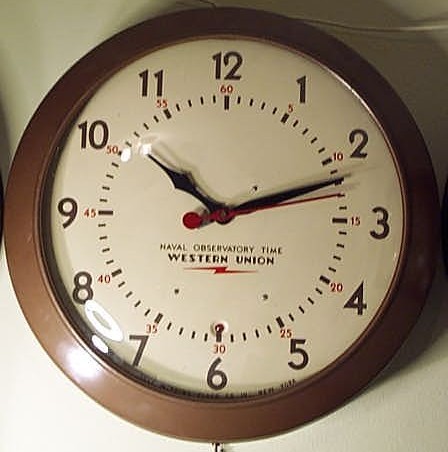Imagine that it's 9:50 on a Sunday morning, the time you set aside each week to wind and adjust each of your eight-day clocks. As you sit at the kitchen table, thinking about getting your keys together before beginning the arduous task, some of your clocks already have a head start. These clocks don't need winding, in fact they have been carefully winding themselves all week. But now, as the new week begins, they may need a slight adjustment of the second or minute hand. Now imagine that at 9:55 AM, your master clock begins the process. Your high-tech "smart" master clock places a telephone call to the U.S. Atomic Clock in Boulder, Colorado to obtain the correct time. Once your "smart" master clock is connected, it receives the exact time from Boulder and checks this against its own time. Noticing that it has been running a bit slow since the last call, your master clock makes a minor adjustment, checks the time once more and hangs up. Ready with the exact time and having corrected for the time zone, your master clock waits until precisely ten o'clock. At exactly ten, it sends a signal throughout your house. All the secondaries immediately sense the signal, and align their second and minute hands straight up. Having synchronized the secondaries, the master is finished and turns off. It's now a few seconds past ten. Your clocks are set and wound. You turn to the next story in the Sunday newspaper, pour another cup of coffee and relax.
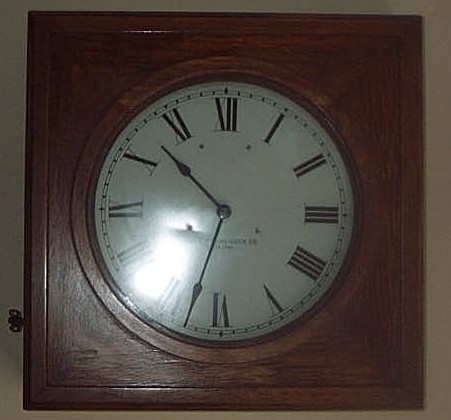
Overview
The preceding scenario is a reality in my household, thanks to a high-tech method I have devised for synchronizing clocks made by the Self Winding Clock Company of New York. These synchronizing clocks can be identified by either "Naval Observatory Time Western Union" or "Synchronized Self Winding" written on the face or located on the case. Originally, these clocks were either local master clocks found in Western Union offices or secondary clocks, synchronized by the local master clock. The master clock was synchronized by a national clock in Washington using the Western Union telegraph lines. The clocks were in operation from the 1890's and diminished in popularity after World War II. 1
Synchronizing these clocks is relatively simple. Each clock contains a solenoid. When energized within about thirty seconds of the hour, the solenoid forces the minute and second hands to point straight up. Signals received by the solenoid at other times are ignored. These clocks were made for Western Union by the Self Winding Clock Company of New York. At 11:50 A.M. each day, Western Union suspended its regular work. Their telegraph wires around the country were turned over to the government for sending time signals. At exactly noon, the Naval Observatory clock in Washington sent out a synchronizing signal to all Western Union Offices east of the Rockies. (Another clock was used for the west coast.) This synchronizing signal set all the Western Union telegraph clocks to noon. From these master clocks, time was distributed hourly to Western Union Offices, stores, jewelers, and other businesses. Western Union provided the clocks, maintenance and time service for a single yearly charge of about $25. 2
Although much has been written about the operation of these clocks, very little attention has been paid to their synchronization capabilities. The method described here simulates the now defunct Western Union Telegraph time distribution system, using the Naval Observatory Atomic Clock as the primary time source, with a local master clock and Self Winding Western Union clocks as secondaries.
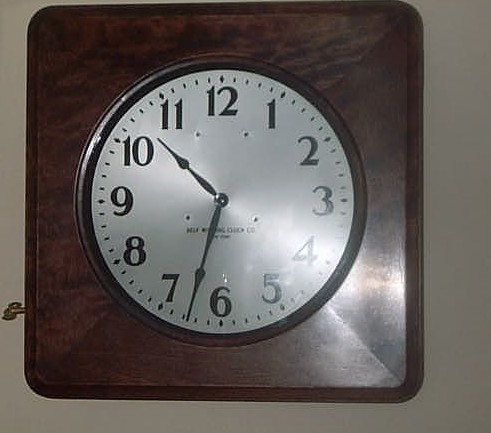
Background
My primary objectives in setting up my high-tech synchronizing system were as follows: to maintain the correct time displayed at each of my Self Winding Clocks with little or no manual intervention, to distribute the synchronizing signal without running any additional wiring through my house, and finally, to design and implement the system at a minimal cost.
This was accomplished by using a personal computer as the local master time clock. My computer is an IBM PC/XT, but the techniques described here should work with almost any personal computer including IBM clones, Commodore, Apple IIe/IIc and Macintosh.
The personal computer receives the time from the US Atomic Clock in Boulder, Colorado on a regular schedule via a modem connection. It transfers this time to an interface unit, which distributes the time, on the hour, to clocks throughout my house using the existing house electrical wiring. The entire system is easy to set up, inexpensive (if you own a personal computer) and operates extremely well. The computer provides a mechanism for obtaining the exact time, however, I provide an alternative method at the end of this article that allows time synchronization without a computer.
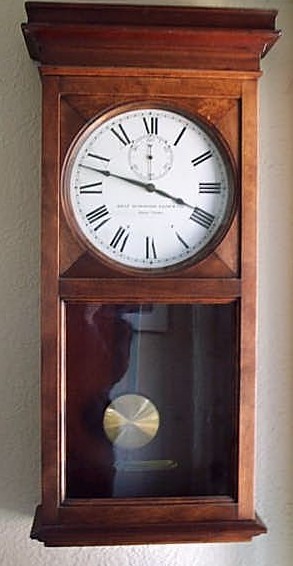
Systems Operation
The basic idea is to set your computer to the exact time as provided by the Atomic Clock and then distribute it around your house. This is accomplished by having the computer call the Automated Computer Time Service (ACTS). ACTS is provided by the U.S. Department of Commerce, National Institute of Standards and Technology (NIST). It is a telephone time service designed to provide computers with telephone access to NIST time at accuracies approaching one millisecond. According to a government publication, features of the ACTS service include automated compensation for telephone-line delay and an ASCII-character time code which operates with standard modems and most computer systems. 3 I have provided information on obtaining the NIST program at the end of this article. Since I am using an IBM PC/XT, the internal clock keeps time only when the machine is operating. Once the machine is shut off, the time is lost and a call to ACTS must be initiated in order to restore the correct time. I am currently setting the computer clock once a week. The call lasts less than one minute, and costs approximately 14 cents when placed during night and weekend rates. There is no charge from NIST for using the time service.
Once the computer has the correct time, the next step is to distribute the time to the Self Winding synchronizing clocks. Since I did not want to run the computer all the time as the master clock, I needed a device that could obtain the time from the computer, and once the time was set, operate independently, distributing the time each hour according to a preset program.
I accomplished this by connecting the computer to the X10 CP290 Home Control Interface. This module is a self-contained unit that can be connected to the IBM PC via the serial communications port. It is fully programmable and once programmed can be disconnected from the computer. The CP290 provides a way to interface real world devices in the home (lights, appliances, air conditioning, coffee-maker) to a personal computer. The CP290 contains an internal clock and is generally used to turn devices in the home on and off at preset times. Since the CP290 uses standard house wiring to distribute the signals, no additional wiring is necessary from the computer to the clocks. The CP290 also eliminates the need for additional complex interface hardware between the clocks and the computer.
The CP290 sends commands through the house wiring such as "TURN ON" and "TURN OFF". Preceding each command code is an address code. These addresses correspond to interface modules that are plugged into standard 110 volt AC outlets. These are essentially relays "listening" for their address on the 110 volt house wiring, and follow the commands whenever their address is transmitted. In order to synchronize a clock, an "ON" command followed immediately by an "OFF" command is transmitted. Since standard X10 appliance modules are designed for 110 volt appliances, I use a special X10 interface module capable of switching low voltages. This module switches a three volt DC transformer connected to the clock's synchronizing solenoid relay whenever the "ON-OFF" command is received. Once an hour, a signal is transmitted from the CP290, received by the X10 module, and the clock solenoid responds by aligning the second and minute hands. Since the CP290 is a self-contained module, once the time and program have been downloaded, it can be completely disconnected from the computer. The program, in this case, is a series of 24 commands, one executed each hour, to synchronize each of the secondary clocks.
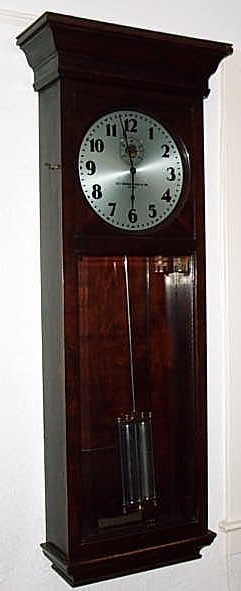
Software Operation
There are two programs required for this synchronization operation. The first is the CP290 control program. This is the sequence of commands that the CP290 executes in order to control devices connected by X10 modules. This program is downloaded to the CP290 by software supplied with the X10. Once the 24 hourly synchronizing signals have been entered into the CP290 from the personal computer, the computer can be disconnected and turned off or used for other purposes. The CP290 operates independently requiring only a connection the 110 volt house wiring. In addition to synchronizing the clocks, the CP290 can store a multitude of commands for other appliances and lights.
The second program sets the PC internal clock as well as downloading the correct time from the PC to the CP290. The CP290 time is set in the following manner. The CP290 operating under its own program switches the computer on at 9:50 AM every Sunday. This is handled by the CP290 issuing an "ON" command to an X10 appliance module connected to the PC. The PC then starts executing its start-up program. This program first uploads the current time stored in the CP290. This sets the PC time and insures that the PC has the time and date in case the connection to ACTS fails. The PC then initiates the NIST ACTS dial program. This program automatically dials Boulder, CO., sets the computer time equal to the time on the Atomic Clock, makes sure the two clocks agree within a specified parameter, and disconnects. The start-up program then downloads the time to the CP290. The computer is automatically turned off by the CP290 after 5 minutes. At this point the CP290 is operating independently of the PC. Since the CP290 time is uploaded to the PC before the call to ACTS, the PC records the difference between the Atomic Clock and the CP290 clock each week.
Once the program has been entered and the time downloaded to the CP290, the computer can be disconnected until there is a need to re-set the CP290, or as in the case described above to make the weekly periodic time adjustments.
Accuracy
Although the time entered into the computer starts out matching closely the time on the Atomic Clock in Boulder, several problems arise in synchronizing to the secondary clocks. First, the PC operating system (DOS) stores the time as an integer that is an offset from a preset defined time. Therefore, it must convert the time provided by NIST to this offset and perform some rounding off since not all times can be represented. Secondly, transferring the time from the computer to the CP290 involves reconverting the time to HH:MM. This will add additional errors into the system. Finally, the actual transfer to the CP290 and the internal processing in setting the CP290 clock add further delays. All of this should change the time by no more than a couple of milliseconds.
This inaccuracy is trivial compared to the error introduced by the Self Winding Synchronizing mechanism itself. For this system to function properly, the synchronizing solenoid on the clock should release at precisely zero minutes, zero seconds past the hour. Unfortunately, the CP290 does not handle commands between minute intervals. Therefore the second hand is released one or two seconds late each hour. The clocks are set slightly fast and make up for this error each hour. Therefore the clocks tend to be within two-three seconds of the Atomic Clock at any given instant. The clocks are able to maintain this accuracy as long as they are running.
Alternatives
An easy alternative to using the PC as a master clock is to use any master clock with some form of programming capability. I have also used a Standard Electric Master Clock that provides a two second pulse each hour. This clock connects to a special X10 interface module that senses a switch closure and sends an X10 "ON" signal. When the switch is opened the module sends an "OFF" signal. This interface module, along with a master clock, will perform the same function as the computer and CP290. Although this system will work in a similar fashion to the computer combination, it will only be as accurate as the master clock used for the synchronization since no connection can be made to ACTS.
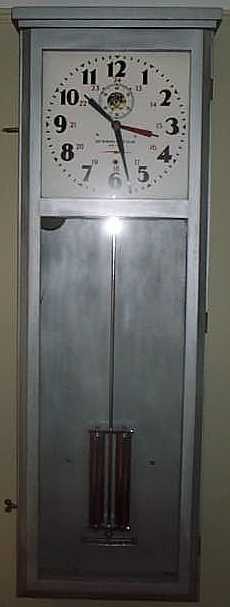
Equipment
All the equipment described in this article is manufactured by the X10 Corporation. There is special software, however, required for automatic operation. I will provide this software free of charge if you send me a self-addressed, postage paid diskette mailer and a formatted diskette. I will handle both 5.25 (low density) and 3.5 inch diskettes and will provide all the necessary software and documentation to bring up the system under MS/DOS (version 3.3 or greater).
The X10 Corporation owns the protocols that are transmitted on the house wiring. They manufacture devices as well as license the technology to other companies. X10 sells directly to the public, however, they encourage consumers to use their retailers. They are located in Northvale NJ. Call (201) 784-9700 if you wish to learn the name of a retailer near you. In addition, all of the equipment described in this article can be purchased via special order from Radio Shack.
The following items are required:
CP290-X10 Computer Interface Price $59.95: This serves as the master clock of the system. It receives the time from the PC, and is used for the hourly time signals to the secondaries.
Radio Shack (61-2688) Sounder/Actuator (X10 UM506) Price $18.95: This connects to the 110 volt house current and senses the signal from the CP290. It then closes an internal relay and allows the attachment of low voltage devices. (The Self Winding Clock solenoid is 3 volts.) Screw terminals are provided for connecting it to the 3 volt power supply and clock synchronizer. Radio Shack (61-2687) Burglar Alarm Interface (X10 PF284) Price $24.95: This module senses a switch closure and sends an "ON" command. When the switch is opened, an "OFF" command is sent. If this module is connected to an hourly switch contact of a master clock it will send an "ON" command followed by and "OFF" command each hour. When combined with the Sounder/Actuator described above it will provide the same function as the personal computer and CP290 combination.
The NIST ACTS software is available directly from the National Institute of Standards and Technology in Gaithersburg MD. The software can be ordered by calling (301) 975-6776. The cost is $43 and credit cards are accepted. The mailing address is National Institute of Standards and Technology Building 202 Room 205, Gaithersburg MD 20899.
The combination of the CP290, the Sounder/Actuator, a PC and the ACTS software from NIST is all that is needed to set up the system described above. If you are interested in fully unattended operation, a special program can be obtained from me to set the CP290 internal clock under program control.
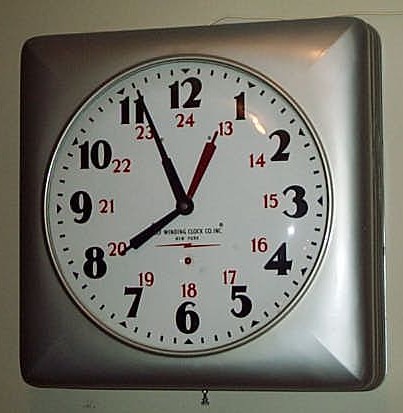
Footnotes
1 American Clocks Volume 2, Tran Duy Ly, Arlington Book Company, 1991
2 Milham, W.I., Time and Timekeepers, MacMillan Co., 1941
3 Research Material 8101 Automated Computer Time Service(ACTS), National Institute of Standards and Technology, Gaithersburg, MD.
[Software is also available by FTP from National Institute of Standards and Technology (NIST)
